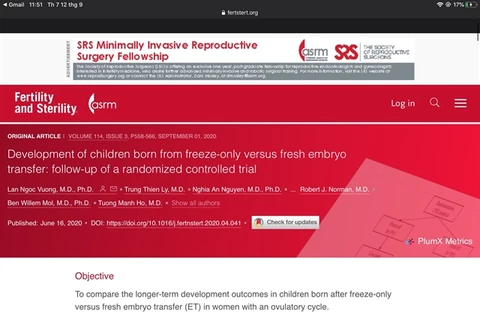Hanoi (VNS/VNA) - Fertility rates over the past two years increased across many localities in Vietnam, and it was even higher than the total replacement birth rate, said Director General of the General Department of Population and Family Planning Nguyen Doan Tu.
According to the general department of Population and Family Planning under the Ministry of Health, fertility rates increased again in 2020, exceeding replacement fertility in many regions.
Specifically, the rate in rural areas increased from 2.11 children per mother in 2010 to 2.29 children per mother in 2020. In addition, rates in the Red River Delta increased from 2.04 children per mother in 2010 to 2.34 children per mother in 2020.
HCM City, a locality with the lowest fertility rate in the country, had a fertility rate of 1.35 in 2017, but by 2021, it reached the rate of 1.48 children per mother.
The city plans to promote fertility to reach 1.6 children per woman by 2030.
Tu said that during the COVID-19 pandemic, couples had more time for each other due to social distancing measures, resulting in increased birth rates.
The fertility rate only exceeded the total replacement birth rate in the short term, he said, adding that a short-term increase in fertility rate was not a matter of concern.
“In many countries with low fertility rates and unsuccessful reproductive promotion, short-term population growth is not a concern,” he said.
However, Vietnam still aims to maintain replacement fertility to ensure each family has two children.
According to a hospital survey, about 200,000-250,000 abortions were recorded yearly, Tu said, adding that the number was still much lower than the reality.
As the age of first marriage increases and the age of first sex decreases, as reported recently, the risk of abortion would increase, he said.
Surveys show that unintended pregnancies account for more than half of abortions./.
According to the general department of Population and Family Planning under the Ministry of Health, fertility rates increased again in 2020, exceeding replacement fertility in many regions.
Specifically, the rate in rural areas increased from 2.11 children per mother in 2010 to 2.29 children per mother in 2020. In addition, rates in the Red River Delta increased from 2.04 children per mother in 2010 to 2.34 children per mother in 2020.
HCM City, a locality with the lowest fertility rate in the country, had a fertility rate of 1.35 in 2017, but by 2021, it reached the rate of 1.48 children per mother.
The city plans to promote fertility to reach 1.6 children per woman by 2030.
Tu said that during the COVID-19 pandemic, couples had more time for each other due to social distancing measures, resulting in increased birth rates.
The fertility rate only exceeded the total replacement birth rate in the short term, he said, adding that a short-term increase in fertility rate was not a matter of concern.
“In many countries with low fertility rates and unsuccessful reproductive promotion, short-term population growth is not a concern,” he said.
However, Vietnam still aims to maintain replacement fertility to ensure each family has two children.
According to a hospital survey, about 200,000-250,000 abortions were recorded yearly, Tu said, adding that the number was still much lower than the reality.
As the age of first marriage increases and the age of first sex decreases, as reported recently, the risk of abortion would increase, he said.
Surveys show that unintended pregnancies account for more than half of abortions./.
VNA
























